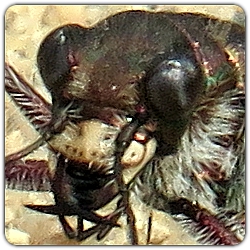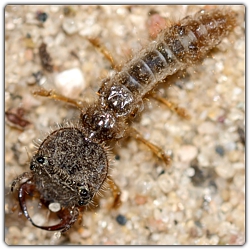
Introduction to the Tiger Beetles of Manitoba
(A preface to "Tiger Beetles of Manitoba: Life History, Ecology and Microsculpture.")
Download the full document below
By Robert E. Wrigley |
Website and document preparation by Doug Collicutt |
Tiger Beetles of Manitoba
Manitoba is host to 19 species of fascinating insects known as tiger beetles (Family Cicindelidae), named for their voracity as predators. With keen eyesight and drone-like tracking skill, they run down moving prey and strike with lightning speed, then crush their victims with their canine-like, multi-toothed mandibles.

Although Manitoba species range in size from only 8 to 21 mm, both larva and adult are capable of overcoming much larger prey, such as a caterpillar and bug. Many species of tiger beetles are beautifully coloured, often with shiny metallic reflections, and feature distinctive and complex patterns on their wing covers. These permit the identification of most species from a distance of a couple of metres with binoculars.
Tiger beetles are among the most widely investigated groups of insects, especially regarding their ecology and geographic distribution. In fact, tiger beetles demonstrate such fascinating ecological relationships and complex life-history traits that they have attracted the keen interest of both professional and amateur entomologists for well over a century. This charismatic group, with over 2700 species described worldwide (on all continents except Antarctica) is now third in public popularity in the insect world only to butterflies and dragonflies, reflected by the fact that many states, provinces, and regions of North America have published accounts on their local tiger beetle fauna.
This, and the attached major research study by the author, provide the first survey focused on the Manitoba species. The following is a list of the tiger beetles species and subspecies (19 species, 24 taxa ) recorded historically in the province:
Laurentian Tiger Beetle, Cicindela denikei
Twelve-spotted Tiger Beetle, Cicindela duodecimguttata
Big Sand Tiger Beetle, Cicindela formosa generosa
Crimson Saltflat Tiger Beetle, Cicindela fulgida fulgida
Crimson Saltflat Tiger Beetle, Cicindela fulgida westbournei
Hairy-necked Tiger Beetle, Cicindela hirticollis shelfordi
Blowout Tiger Beetle, Cicindela lengi versuta
Common Claybank Tiger Beetle, Cicindela limbalis
Sandy Tiger Beetle, Cicindela limbata hyperborea
Sandy Tiger Beetle, Cicindela limbata nympha
Long-lipped Tiger Beetle, Cicindela longilabris longilabris
Prairie Long-lipped Tiger Beetle, Cicindela nebraskana
Cow Path Tiger Beetle, Cicindela purpurea audubonii
Cow Path Tiger Beetle, Cicindela purpurea purpurea
Bronzed Tiger Beetle, Cicindela repanda repanda
Festive Tiger Beetle, Cicindela scutellaris lecontei
Oblique-lined Tiger Beetle, Cicindela tranquebarica kirbyi
Oblique-lined Tiger Beetle, Cicindela tranquebarica tranquebarica
Punctured Tiger Beetle, Cicindelidia punctulata punctulata
Coppery Tiger Beetle, Ellipsoptera cuprascens
Ghost Tiger Beetle, Ellipsoptera lepida
Nevada Tiger Beetle, Ellipsoptera nevadica knausii
Variable Tiger Beetle, Parvindela (Cylindera) terricola cinctipennis
Variable Tiger Beetle, Parvindela (Cylindera) terricola terricola

Creatures of the Sun
Tiger beetles are truly creatures of the sun, being most active on sunny days with an ambient temperature over 14°C. While mainly diurnal, several species are also active at night. They hibernate in deep burrows (as larvae and/or adults) for at least six months during the winter, and usually live as active adults in summer for from three to six weeks. A major reason of the group’s success is its ability to exploit challenging habitats, such as saline mudflats and barren sand dunes, which are shunned by most other kinds of insects (thereby avoiding competition).
Certain species of tiger beetles are found in a great variety of habitats and occur over a large range, such as Oblique-lined Tiger Beetle, while others are entirely dependent on a specific type of habitat; examples being the Ghost Tiger Beetle on open sand, and the Crimson Saltflat Tiger Beetle on soil of high salt content. Consequently, the distributional patterns of the latter species are generally discontinuous, with often-small populations separated by great distances, and therefore susceptible to extirpation.
Northern Manitoba has six species of tiger beetles (Long-lipped, Common Claybank, Sandy, Oblique-lined, Bronzed, and Twelve-spotted), the central region has an additional four (Blowout, Hairy-necked, Cow Path, and Variable), while all 19 species have occurred historically in the extreme south of the province. With the major loss of prairie, aspen parkland, and mixed-forest habitats to agriculture and other developments in Manitoba, many populations of tiger beetles have been reduced or eliminated within the last two centuries. It appears that the Nevada and Coppery tiger beetles are extirpated from the province, as none has been observed at their single localities for over half a century.

The two most important limiting resources for tiger beetles are food and egg-laying sites, since the rate of food intake by the larva affects the size of the growing larval stages and the adult, which in turn affects adult reproduction. A tiger beetle larva is remarkable for its ambush-style hunting technique while sitting in wait at the burrow entrance for an occasional passing prey. With acute eyesight and sensitivity to vibration, the larva detects an approaching prey and leaps out backwards with blinding speed and grasps its unsuspecting victim in its large mandibles. The larva then drags it to the bottom of the burrow for processing. A prominent set of hooks on the larva’s back helps prevent it from being dragged out of its burrow by a large prey or predator. With a dependence on suitable prey (e.g., ants, beetles, flies) coming into range, the larva may take from one to four years (depending on the species) to complete its successive moults, to pupate, and to emerge as an adult on the surface.
For in-depth information on tiger beetles, please download the attached publication:
“Tiger Beetles of Manitoba: Life History, Ecology and Microsculpture” by Robert E. Wrigley with colour photographs of species by Larry de March and scanning electron photomicrographs by Erwin Huebner.
The objectives of this paper are to provide a summary of the beetles’ life history, ecology, and behaviour, based on the author’s observations and those reported in the literature, and to encourage others to undertake observations and ecological studies of these fascinating insects.
Download the updated (March 2022)
version
of this publication at this link:
The Tiger Beetles of Manitoba (98 Mb, PDF).

Please respect the author's and contributors' copyrights on the contained materials. Thank-you.
Acknowledgments
The results presented in this paper are derived from countless field trips conducted around the province by the author and several other researchers, past and present, covering a period of 115 years. Two names stand out as pioneers in this field – Norman Criddle (1875-1933), who conducted his extensive studies in the early 1900s on his family farm at a place called Aweme in the Carberry Sandhills, and J.B. Wallis (1877-1961), a Manitoba school teacher and principal who made a major contribution to Manitoba and Canadian entomology, culminating in his 1961 book; “The Cicindelidae of Canada.” The J.B. Wallis/R.E. Roughley Museum of Entomology, University of Manitoba, was named in his honour.
The author, Dr. Robert Wrigley, is a retired mammalian ecologist, and former Manitoba Museum Curator and Museum Director, the founding Director of the Oak Hammock Marsh Interpretive Centre, and later the Curator of the Assiniboine Park Zoo. He was introduced to tiger beetles in the mid-1970s and has researched tiger beetles in Manitoba and United States periodically from 1994 to 2020.
Photographer Larry de March is a retired biologist, formerly a Director of Resource Management with Fisheries and Oceans Canada. Always interested in nature, he photographs wildlife and studies the distribution of tiger beetles, odonates, and wildflowers.
Cell Biologist, Dr. Erwin Huebner, Professor Emeritus in the Department of Biological Sciences at the University of Manitoba, and Artist in Residence in the School of Art, integrates the worlds of microscopic life and art. Dr. Huebner's scanning electron micrographs of several species of tiger beetles are presented.
Biologist, Doug Collicutt, operates NatureNorth.com website and prepared the Tiger Beetles of Manitoba web page and formatted the PDF document.
Thanks for learning about Manitoba's Tiger Beetles!
| You can help NatureNorth produce more great articles with a secure donation through PayPal. Our Google Adsense ads pay our server costs, but that's about it. To learn more follow this link: Support NatureNorth. Thank-you! | |
Return to: Top of Page | Summer Issue | NatureNorth Front page
